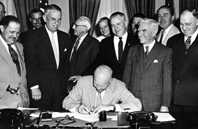A Brief History of Veterans Day
Veterans Day, formerly known as Armistice Day, was originally set as a U.S. legal holiday to honor the end of World War I, which officially took place on November 11, 1918. In legislation that was passed in 1938, November 11 was "dedicated to the cause of world peace and to be hereafter celebrated and known as 'Armistice Day.'" As such, this new legal holiday honored World War I veterans.
In 1947, Raymond Weeks, of Birmingham Ala., organized a "Veterans Day" parade on November 11th to honor all of America's veterans for their loyal and dedicated service. Shortly thereafter, Congressman Edward H. Rees (Kansas) introduced legislation to change the name of Armistice Day to Veterans Day in order to honor all veterans who have served the United States in all wars.
In 1954, President Eisenhower signed a bill proclaiming November 11 as Veterans Day, and called upon Americans everywhere to rededicate themselves to the cause of peace. He issued a Presidential Order directing the head of the Veterans Administration (now called the Department of Veterans Affairs), to form a Veterans Day National Committee to organize and oversee the national observance of Veterans Day.
In 1968, the Uniforms Holiday Bill ensured three-day weekends for federal employees by celebrating four national holidays on Mondays: Washington's Birthday, Memorial Day, Veterans Day, and Columbus Day. Under this bill, Veterans Day was moved to the last Monday of October. Many states did not agree with this decision and continued to celebrate the holiday on its original date. The first Veterans Day under the new law was observed with much confusion on Oct. 25, 1971.
Finally on September 20, 1975, President Gerald R. Ford signed a law which returned the annual observance of Veterans Day to its original date of Nov. 11, beginning in 1978. Since then, the Veterans Day holiday has been observed on Nov. 11.

No comments:
Post a Comment